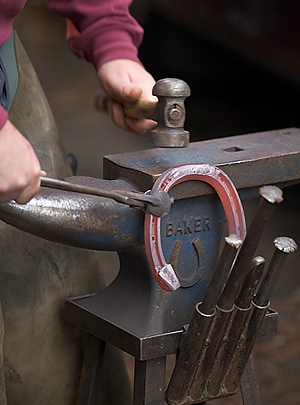Farrier
Tasks & duties

Farriers may do some or all of the following:
-
discuss the type of horseshoe required with the horse's owner or trainer
-
observe the horse's legs and check the size and shape of the hooves
-
remove worn or faulty shoes
-
check the hooves for problems such as bruising or infections
-
clean, trim and measure the hooves
-
select and cut the metal, and select suitable nails
-
heat shoes in a forge, shape them on anvils and hammer them to size
-
nail the shoes to the hooves
-
tidy the hooves using rasps (files)
-
be involved in correcting the horse's legs or stance such as rectifying bent legs or limb deformation in foals
-
run their own business
Skills & knowledge
Farriers need to have:
-
practical skills for making horseshoes
-
knowledge of the various metals used in horseshoes and the wearing qualities of different shoes
-
skill shaping and forging metals
-
understanding of how shoeing affects horses' performance and health
-
knowledge of horse behaviour and anatomy
-
knowledge of hoof infections
-
good horse-handling skills
-
good problem-solving skills
-
understanding of safe working practices
Farriers who run their own business need to have business management knowledge.
Entry requirements
To become a farrier you need to work under the supervision of a senior farrier. Trainee farriers work towards the National Certificate in Equine (Farriery), which is gained on the job and supported by block courses. Apprenticeships are also available through the New Zealand Equine Training Scheme.
Secondary education
Three years of secondary school education is useful.
Useful experience
Work as a groom or stablehand, or work with livestock is good experience for those wanting to become farriers.
Related courses
Equine Trades
Document Actions
